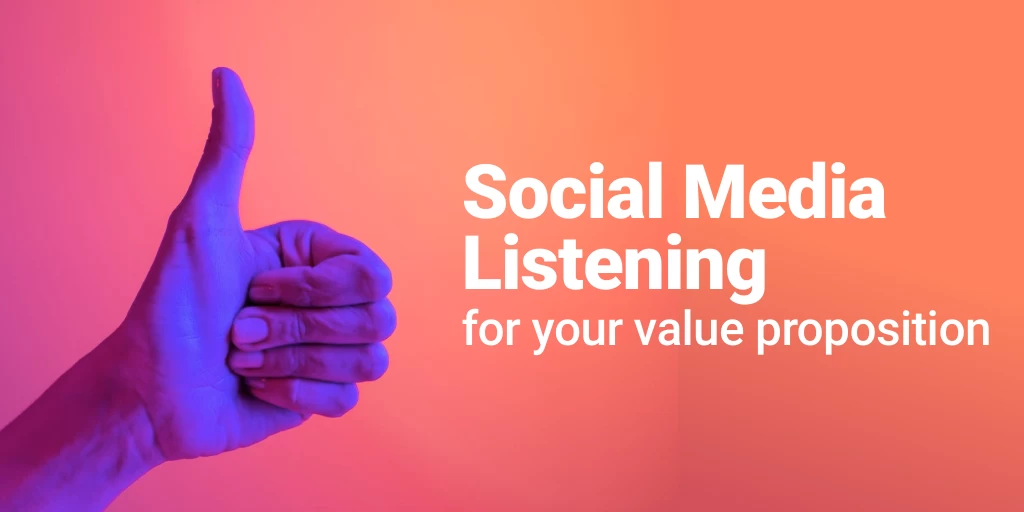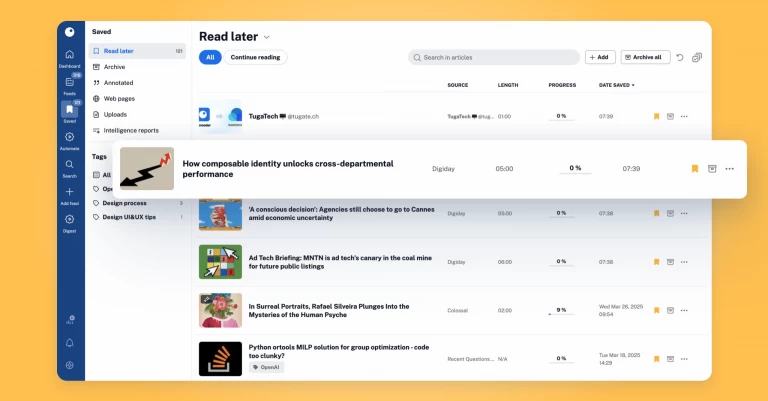Social Media Listening For Your Value Proposition

To survive, brands have to emphasize on the value they bring to their customers – a task further complicated by the shift in power dynamics between customer and company. Another factor to accommodate is the approach to purchasing most people demonstrate.
Customers compare brands in greater detail and are more discerning. Concepts like sustainability, ethical practices and social responsibility mark how customers select products and brands. Social media listening continuously informs you on your target audience’s preferences, beliefs and needs. Discover valuable insights into how to better position your product and refine the messaging that defines your value proposition.
Social media listening supplies you with crucial data on consumer behavior and paint points, but it also opens a direct channel of communication. In the past, companies had to pay for focus groups and pop-up promotions, where customers tested new products.
Now, you’re one click away from collecting the same information without the financial barrier – a welcome change in pace for smaller businesses and start-ups, who might otherwise not have the budget for such research.
You can’t beat social media listening as a practice for marketing development, but let’s take a look at the role of value proposition today.
The value proposition and its importance
One way or another, every business strives towards establishing themselves as the better choice in their chosen market. Incidentally, this is the pure essence of the unique value proposition that’s at the centre of modern branding in the social media age. It’s the promise of value only you provide that triggers interest in potential buyers and turns first-time customers into repeat customers.
Every line of text on your website is a chance to communicate your value proposition and convince a visitor to buy your product or service – homepage, product pages, category pages, social media posts. Experiment and see how to best hone your superiority over your competitors. Admittedly, this is easier for brands that have been around for years and have built a strong reputation as well as rapport with their customer base. The brand name itself carries a value proposition, which is not so much articulated as it is felt and understood on a subconscious level.
If smaller businesses and newcomers hope to have a fighting chance, their focus should squarely fall onto refining their value proposition. It’s what converts leads to sales, and it’s why you must test it out time and time again until you find the one that clicks best for your target customers.
What is a value proposition?
It’s all well and good, but you might not be quite on the same page as to what a value proposition entails. A good value proposition communicates why a customer should select your brand over many others on the market and relies on three distinct components – differentiation, relevancy and quantified value.
Differentiation gives your brand a distinct flavor. What makes you cool and desirable? What puts you on the map messaging wise? Now that you grab the attention, you move onto relevancy – the core of the product. How does your product or service make life easier for the customer? What are the problems it resolves?
Last but not least, there’s quantified value, which answers the question as to how your brand makes life easier for your target audience. Don’t be vague about it. Signal as loud as possible the strengths and unique features your product possesses.
Most importantly, you have to mean it. Value propositions should not be used as stylistic finishing on your website to punch up your sales copy. Rather, value propositions are the beating heart at the core of your business, which directs all other marketing efforts in the long run. A strong core promises longevity within a highly competitive industry.
Why value proposition is key for businesses in the 21st century?
‘Build it and they will come’ no longer works for the market landscape molded thoroughly by late stage capitalism. Customers have more choice than ever before and social media equalizes brand and buyer in a lot of ways. Communication redistributes power towards the consumer and today, companies have to put more elbow grease in retaining and gaining business.
Selling has moved away from product-centric marketing to customer-centric marketing. That’s why a customer value proposition should become the gravitational pull that binds all messaging, campaigns, interactions and marketing strategies together. You want to carve out a comfortable niche, where you’re different enough from competitors to hold your ground and consistently build up your audience.
Engagement, informing and honesty are what instill loyalty within your customers, so you retain existing customers. Social media is key to this relationship building and it’s why through effective social media listening you can fine tune your branding to achieve the most. Communicating clear value propositions also assist in converting prospect buyers into direct sales. You will discover a lot of tricks and strategies to compel potential customers to give your product a try.
But you have to remember, the customer of today has an informed opinion so it’s best to talk with them rather than talk at them.
Social media listening to help you redefine your value proposition
Arriving at an effective value proposition ought to be an ever-developing process. You shouldn’t treat it as a one-time task, which you can dust your hands of and call it a day. Ideally, your brand should constantly evolve, because your customer base will most definitely change their minds as to what they need over time.
Social media listening keeps your fingers on the pulse of what’s the most current for customers at any given moment. Certainly some core aspects of your value proposition will remain as far as the quality of products and services go, but there are far more intangible benefits you can bring to the table.
And all of them circle around the relationship you maintain with your customers. At the risk of sounding like a broken record, social media sparks connections and maintains conversations. That in itself enriches the unique value propositions of your brand. What you should do is:
Solve customers’ problems and answer customers’ questions
Running corporate social media accounts, you might wrap yourself up into the daily schedule you have to maintain for promotional posts and news. However, that’s a very one-sided way in looking at your online presence. Social media exists to have conversations you otherwise wouldn’t have had – namely your greatest resource, your customers themselves.
It’s social media listening without having to leave your feeds.
Timely interactions with customers, when they reach out, makes all the difference in the long run as you demonstrate you care for their interests and overall experience. Replying to customers on Twitter and Facebook establishes loyalty, especially if you’re solving problems. This can play out in several different scenarios:
- You address a direct complaint regarding your product and service. In this scenario, it’s key to answer as quickly as you’ve seen it and never take longer than a day. Take action and follow through on your promise to resolve issues.
- Sometimes customers might have problems they need solving without there being a complaint pointed at you. Here you step into the role of an educator. Do you have insights into your customers’ potential problems that you’re well versed in? Share your discoveries with the rest of your class. Diversifying your content with more than self-promotion creates a level of authenticity to your digital presence.
- Step in to solve problems customers of your competitors’ products might have. Remember when we said you should respond to customer complaints? This is why. You’re using social media listening to poach customers from your competitors and convert them.
Listen and engage with your audience
Right, we’ve reached the point where social media listening really kicks in. You should establish the channels you want to keep an eye on – look beyond your DMs and profiles. Customers discuss their experiences with companies on a variety of channels without expressly tagging brands and that’s the untapped potential you need to develop your value proposition.
Create Google Alerts for your brand and product names, head on over to Quora and Reddit, which you can monitor with specific tools, follow specific industry and campaign hashtags on Twitter. You don’t even need a specialized tool for the last one, when you have the current generation of RSS readers at your disposal. Inoreader enables users to subscribe not only to specific accounts or lists, but also hashtags, which makes social media listening a breeze.
Although being a digital fly on the wall earns certain insights you might not otherwise get, don’t forget to ask your audience point blank about their preferences and needs. Yes, customers love it when brands respond to inquiries and requests, but you’re missing out, if you’re not initiating new conversations on your own accord.
Develop a customer centered value proposition
What we’re building up to is the concept of a customer-centric value proposition. How you take care of your customers is just as enticing as a value proposition as the quality of your products. If you create the reputation as a brand with committed customer support, then customers are likelier to stay by your side.
That’s the innate power of social media and through the previous two steps, your brand cements its position among other long-term players on the market.
How to “listen” to your social media successfully?
Onto practical application! How does social media listening work exactly? We’ve talked about the importance in keeping your ear to the ground as it were, whether that’s to monitor how customers interact with competitors or what they’re saying elsewhere. Factor in that people make errors when they type, and add to your keywords common misspellings of your brand name and products, so you capture more insights.
Hands-on approach to social media listening can involve personally monitoring LinkedIn Groups and Facebook Groups, which match the interests of your ideal customers. How do you find out where these people go? Hint, hint – ask your existing customers for any leads.
Social media listening can be as simple and inexpensive as setting up multiple Google Alerts for important keywords.
Pro Trip: If you want to avoid clogging your inbox with GA emails, then you can easily turn to RSS feed readers to streamline the experience. Another route you can go is to invest in specific tools, which dive into data gathering and analysis. You will be surprised at how broad or tightly specialised tools are available, and choosing might take a little while until you land on the perfect match.


